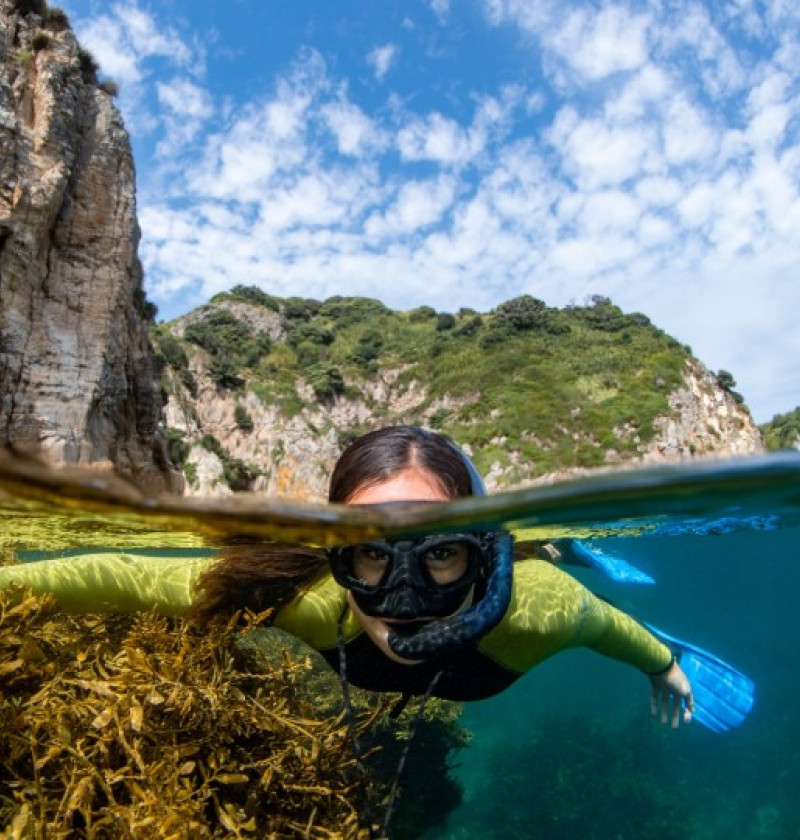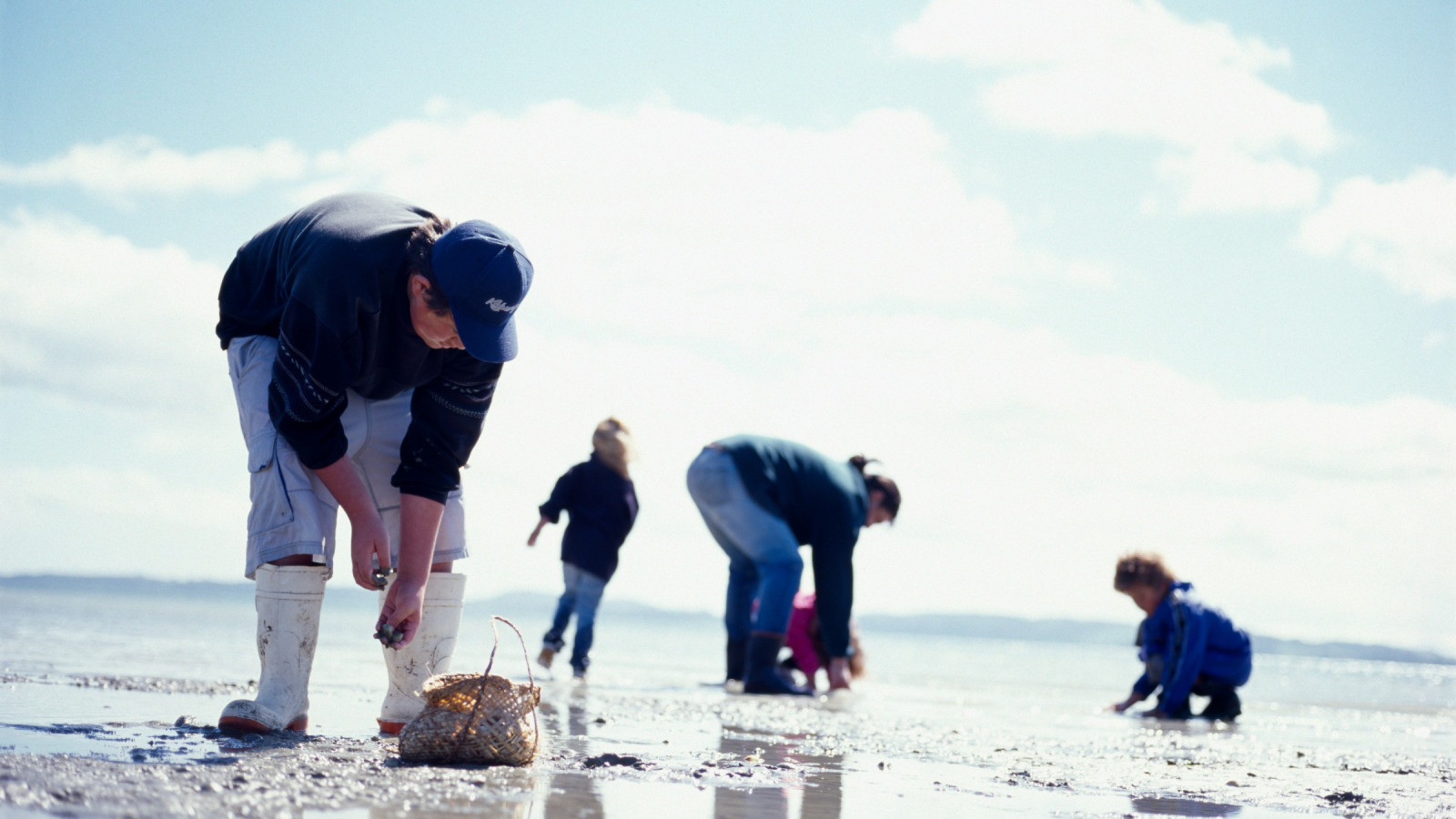What the marine environment means to New Zealanders

Te moana is deeply embedded in our culture, identity, and history.* As an island nation, many of our ancestors arrived by waka and by boat. We are drawn to the coasts and approximately 65 percent of New Zealanders live within 5 kilometres of the sea. Much of our major infrastructure is close to the coast (OECD, 2019).

Image: Sandii McDonald, Photo New Zealand
The Māori relationship with te moana is based on whakapapa and a long history of people who were astronomers, scientists, ocean navigators, fishers, and regulators. Before colonisation, the Māori economy was based on fishing and a comprehensive trading system. Advanced fishing methods were used – some nets used at Maketu in the Bay of Plenty were up to 1,900 metres long. In addition, the people of Muriwhenua in the Far North identified and named hundreds of fishing grounds within 25 miles offshore, including seasonal descriptions and the species present (Waitangi Tribunal, 1988).
As treaty partners, Māori have a role as kaitiaki of te moana and mātaitai (fish or food obtained from the sea). Kaitiaki are guardians who carry out the act of tiaki and look after, protect, and conserve the resource or taonga; kaitiaki can be a human, animal, or a spiritual being. This role and the close relationships that Māori have with the moana are acknowledged by the Crown and reflected in Treaty settlements and post-settlement agreements.
* In this report ‘moana’ describes a holistic view of our coasts and oceans, although it can have wider and narrower definitions.
New Zealand’s exclusive economic zone (EEZ) extends from 12 to 200 nautical miles from the coast. It is one of the biggest in the world and 15 times larger than our land area. The coastline is estimated at 15,000 kilometres – one of the longest in the OECD – while our population is one of the smallest (LINZ, 2019; OECD, 2019).
As a long, narrow and isolated island nation, our marine environment has a high level of local variation. Ocean currents and diverse undersea landscapes also allow different communities to flourish. Local uniqueness and an extensive Pacific history is reflected in mātauranga Māori (the body of knowledge passed down from Māori ancestors, which includes worldviews, perspectives, and practices). Mātauranga Māori provides knowledge about changes in the environment across generations, and is strongly associated with a place. This pursuit and application of knowledge is continually adapted and incorporated into people’s lives (Ataria et al, 2018; Hikuroa, 2017).
More than 17,000 species have been recorded in our EEZ and the marine environment accounts for up to 30 percent of Aotearoa New Zealand’s biodiversity (Gordon et al, 2010). There is still much to learn about our marine biodiversity and its ecosystems. More than 4,000 currently known species have not yet been studied in detail and new species are discovered regularly. The number of known fish species increases by about 20 species per year and about half of these are new to science (Gordon et al, 2010).
When the mauri (life force and essential quality and vitality of living things) of the moana is healthy it enhances the mauri of humans who are in contact with it. In te ao Māori (the Māori world and worldview) people are spiritually connected with the oceans, waitai (water from the sea), and with species and elements of the moana. Waitai also spiritually cleanses and heals wairua (the spirit or soul of a person).
Conversely, an unhealthy mauri has a destructive effect on our mauri. An unhealthy marine environment affects our physical, mental, and spiritual health. It also impacts Māori ability to manaaki tangata (provide hospitality and generosity to others), including providing food for people and guests. This can affect the mana of both giver and receiver of manaaki.
Healthy marine ecosystems provide other essential benefits (or ecosystem services) that are not easy to measure. Some benefits include climate regulation, as oceans take up carbon dioxide, and seagrasses or mussel beds providing shelter for young fish (Geange et al, 2019).
Our marine environment supports our economy and provides jobs, especially in shipping, fishing and aquaculture, and offshore minerals. In 2017, New Zealand’s marine environment was estimated to add at least $7 billion to our economy (Stats NZ, 2019a). This estimate does not cover some sectors of the marine economy like research or education.
Current estimates of the value of the marine economy do not take into account the non-market value of the marine environment, or count the cost of environmental degradation caused by our activities.
Under the Environmental Reporting Act 2015 (the Act), the Secretary for the Environment and the Government Statistician must produce regular reports on the state of our environment.
Under the Act, a report on a domain (marine, freshwater, land, air, and atmosphere and climate) must be produced every six months and a whole-of-environment (or synthesis) report every three years. Each domain report has now been published once (see Environmental reporting series for the full list). The most recent synthesis report, Environment Aotearoa 2019, was published in April 2019. The previous marine report was Our marine environment 2016.
Our marine environment 2019 begins the second cycle of domain reporting. It updates Environment Aotearoa 2019 and Our marine environment 2016 by presenting new data and insights.
As required by the Act, state, pressure, and impact are used to report on the environment. The logic of the framework is that pressures cause changes to the state of the environment and these changes have impacts. The report describes impacts on ecological integrity, public health, economy, te ao Māori, culture, and recreation to the extent that is possible with the available data.
Suggesting or evaluating any responses to environmental impacts is out of scope under the Act. Therefore, this report does not cover the work that organisations and communities are doing to mitigate the issues. It does provide an update on the most recent data about the state of the marine environment. The evidence in this report is a basis for an open and informed conversation about what we have, what we are at risk of losing, and where we can make changes.
When reviewing Environment Aotearoa 2015, the Parliamentary Commissioner for the Environment suggested structuring future synthesis reports according to issues, where an issue is defined as:
…a change in the state of the environment that is (at least partly) caused by human activities (pressures) and has consequences (impacts).
Taking a whole system approach, Environment Aotearoa 2019 identified nine priority environmental issues facing New Zealand (table 1).
Four criteria were established to identify and help describe the sense of significance and urgency of the issue:
Spatial extent and scale - how much of New Zealand is affected by the issue?
Departure from natural conditions - is the issue increasing in scale and/or distribution or accelerating?
Irreversibility and lasting effects of change - how hard is it to fix?
Scale of effect on culture, recreation, health, and economy - how much does it affect the things we value?
This report provides more in-depth information about how the issues in Environment Aotearoa 2019 relate to the marine environment. It focuses on four priority issues identified using the criteria described above.
Table 1 has more detail about each issue.
This is not an exhaustive list of all the issues our marine environment faces. Some issues have an impact on the marine environment but are not featured as they do not rank as highly against the criteria as other issues.
For each issue, this report addresses four questions:
The final section describes how the effects associated with the four issues overlap and interact in local environments, resulting in cumulative effects. This can sometimes offset impacts but more often results in new or increased impacts. To demonstrate this we have woven the story of kuku (or kūtai), the New Zealand green-lipped mussel, through each issue. Kuku are an important traditional food source for Māori and considered a significant taonga (treasured object, resource, idea, or technique).
Our marine environment 2019 also describes significant gaps in our knowledge that, if filled, would improve our ability to respond to the issues identified in this report.
| Themes from EA2019 |
Issue from: Environment Aotearoa 2019 (EA2019) identified nine priority environmental issues across all domains. |
Relates to issue in: Our marine environment 2019 (this report) discusses four priority environmental issues in the marine domain. |
New data and insights since EA2019 |
|---|---|---|---|
| Our ecosystems and biodiversity | 1. Our native plants, animals and ecosystems are under threat | 1. Our native marine species and habitats are under threat |
New data on:
|
|
How we use our land |
2. Changes to the vegetation on our land are degrading the soil and water
|
2. Our activities on land are polluting our marine environment |
New data on:
|
| Pollution from our activities |
4. Our waterways are polluted in farming areas
|
||
| How we use our freshwater and marine resources |
6. Taking water ecosystems changes flows which affects our freshwater
|
3. Our activities at sea are affecting the marine environment |
New data on:
|
| Our changing climate |
8. New Zealand has high greenhouse gas emissions per person
|
4. Climate change is affecting marine ecosystems, taonga species, and us |
New data on:
|
| All our activities put cumulative stress on the marine environment. |
Data, upon which this report is based, came from many sources including Crown research institutes, central government, and regional councils. Further supporting information was provided using a ‘body of evidence’ approach. This is defined as peer reviewed, published literature, and data from reputable sources. This also includes mātauranga Māori and observational tools used to identify changes in an ecosystem.
These signs and signals of the natural world, ngā tohu o te taiao or tohu, are often referred to as environmental indicators. Māori environmental practitioners use them to identify trends or changes in the state or health of marine environments, for example stingrays as an indicator of seabed health (Faulkner & Faulkner, 2017). Data related to the sustainability of fisheries was sourced from recently published literature like the 2018 Aquatic Environment and Biodiversity Annual Review (Ministry for Primary Industries, 2019).
All the data used in this report, including references to scientific literature, was corroborated and checked for consistency. The report was reviewed by a panel of independent scientists. The indicators related to the marine environment and the date they were last updated is available in the Environmental reporting series.
This report is supported by other products that are published by the Ministry for the Environment and Stats NZ:

What the marine environment means to New Zealanders
October 2019
© Ministry for the Environment